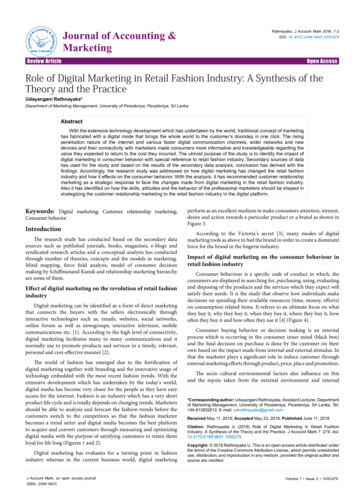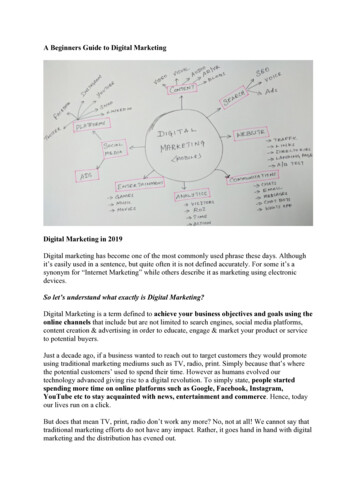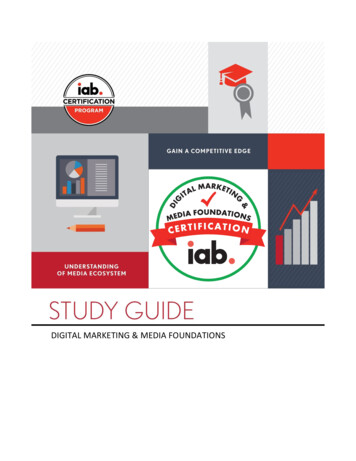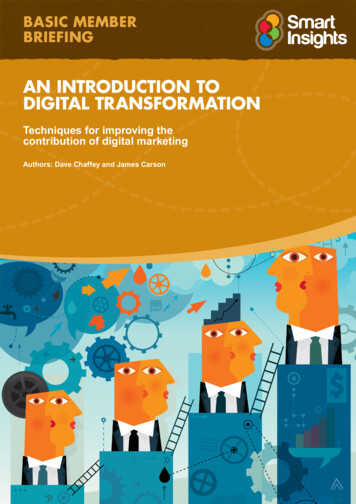
Transcription
rketingMaurnal ofJoRathnayaka, J Account Mark 2018, 7:2DOI: 10.4172/2168-9601.1000279Journal of Accounting &Marketing&countingAcISSN: 2168-9601Review ArticleOpen AccessRole of Digital Marketing in Retail Fashion Industry: A Synthesis of theTheory and the PracticeUdayangani Rathnayaka*Department of Marketing Management, University of Peradeniya, Peradeniya, Sri LankaAbstractWith the extensive technology development which has undertaken by the world, traditional concept of marketinghas fabricated with a digital mode that brings the whole world to the customer’s doorstep in one click. The risingpenetration nature of the internet and various faster digital communication channels, wider networks and newdevices and their connectivity with marketers made consumers more informative and knowledgeable regarding thevalue they expected to return to the cost they incurred. The utmost purpose of the study is to identify the impact ofdigital marketing in consumer behavior with special reference to retail fashion industry. Secondary sources of datahas used for the study and based on the results of the secondary data analysis, conclusion has derived with thefindings. Accordingly, the research study was addressed on how digital marketing has changed the retail fashionindustry and how it effects on the consumer behavior. With the analysis, it has recommended customer relationshipmarketing as a strategic response to face the changes made from digital marketing in the retail fashion industry.Also it has identified on how the skills, attitudes and the behavior of the professional marketers should be shaped instrategizing the customer relationship marketing to the retail fashion industry in the digital platform.Keywords: Digital marketing; Customer relationship marketing;Consumer behaviorIntroductionThe research study has conducted based on the secondary datasources such as published journals, books, magazines, e-blogs andsyndicated research articles and a conceptual analysis has conductedthrough number of theories, concepts and the models in marketing.Mind mapping, force field analysis, model of consumer decisionmaking by Schiffmanand Kanuk and relationship marketing hierarchyare some of them.Effect of digital marketing on the revolution of retail fashionindustryDigital marketing can be identified as a form of direct marketingthat connects the buyers with the sellers electronically throughinteractive technologies such as, emails, websites, social networks,online forum as well as newsgroups, interactive television, mobilecommunications etc. [1]. According to the high level of connectivity,digital marketing facilitates many to many communications and itnormally use to promote products and services in a timely, relevant,personal and cost-effective manner [2].The world of fashion has emerged due to the fortification ofdigital marketing together with branding and the innovative usage oftechnology embedded with the most recent fashion trends. With theextensive development which has undertaken by the today’s world,digital media has become very closer for the people as they have easyaccess for the internet. Fashion is an industry which has a very shortproduct life cycle and is totally depends on changing trends. Marketersshould be able to analysis and forecast the fashion trends before thecustomers switch to the competitors so that the fashion marketerbecomes a trend setter and digital media becomes the best platformto acquire and convert customers through measuring and optimizingdigital media with the purpose of satisfying customers to retain themloyal for life long (Figures 1 and 2).Digital marketing has evaluates for a turning point in fashionindustry whereas in the current business world, digital marketingJ Account Mark, an open access journalISSN: 2168-9601perform as an excellent medium in make consumers attention, interest,desire and action towards a particular product or a brand as shown inFigure 3.According to the Victoria’s secret [3], many modes of digitalmarketing tools as above to fuel the brand in order to create a dominantforce for the brand in the lingerie industry.Impact of digital marketing on the consumer behaviour inretail fashion industryConsumer behaviour is a specific code of conduct in which, theconsumers are displayed in searching for, purchasing, using, evaluatingand disposing of the products and the services which they expect willsatisfy their needs. It is the study that observe how individuals makedecisions on spending their available resources (time, money, efforts)on consumption related items. It referes to an ultimate focus on whatthey buy it, why they buy it, when they buy it, where they buy it, howoften they buy it and how often they use it [4] (Figure 4).Consumer buying behavior or decision making is an internalprocess which is occurring in the consumer inner mind (black box)and the final decision on purchase is done by the customer on theirown based on the impact made from internal and external stimulus. Inthat the marketer plays a significant role in induce customer throughexternal marketing efforts through product, price, place and promotion.The socio cultural environmental factors also influence on thisand the inputs taken from the external environment and internal*Corresponding author: Udayangani Rathnayaka, Assistant Lecturer, Departmentof Marketing Management, University of Peradeniya, Peradeniya, Sri Lanka, Tel: 94-813832612; E-mail: urkrathnayaka@gmail.comReceived May 11, 2018; Accepted May 23, 2018; Published June 11, 2018Citation: Rathnayaka U (2018) Role of Digital Marketing in Retail FashionIndustry: A Synthesis of the Theory and the Practice. J Account Mark 7: 279. doi:10.4172/2168-9601.1000279Copyright: 2018 Rathnayaka U. This is an open-access article distributed underthe terms of the Creative Commons Attribution License, which permits unrestricteduse, distribution, and reproduction in any medium, provided the original author andsource are credited.Volume 7 Issue 2 1000279
Citation: Rathnayaka U (2018) Role of Digital Marketing in Retail Fashion Industry: A Synthesis of the Theory and the Practice. J Account Mark 7:279. doi: 10.4172/2168-9601.1000279Page 2 of 7Changing FashionTrendsIncreased internet penetrationleads to more engagement withonline platforms (40% fromglobal population)Busy Life schedulesreasoned to onlineshoppingRole of Digital Marketingin Retail Fashion IndustryBrand concern and statusconcern customersAvailability of onlineinformation on fashion brands inwide varieties.Active presence ofbusinesses in socialnetworking platforms7/24 service andconstantly updating latestinformationAccess to global brandsand customers.Figure 1: Mind Map for the role played by digital marketing in retail fashion industry.Technological Literacy issues to access Digital mediaCost Effectiveness in awareness building and promotionsand ability to reach a larger audienceAbility to enhance and harvest the content PerformanceLimited availability of alternative product varietiesLead Generation and improved conversion ratesSecurity issues of payment procedure and gatewaysRole of Digital MarketingAbility to grow higher Revenuesin Retail Fashion IndustryAbility to compete with global competitorsResistant to change with modern technology and culturalbarriersRapid changing trends and Out of style the out fitsEnhance Brand reputation & Brand trustEasy to imitate the online campaigns and promotionsResults and the performance can be measurableRestricted budget to optimize Digital mediaFigure 2: Force field analysis.environment are fed in to the process where the customer identify theirneed, search and evaluate alternatives and make decisions according totheir psychological conditions. After the decision on purchase, the postpurchase evaluation will be happened to whether to trial or to make arepeat purchase.With the extensive availability of information, today’s consumersbecame more knowledgeable and powerful as they are capable ofevaluating information and purchase the best option. So makingavailable information and active presence in online environmentJ Account Mark, an open access journalISSN: 2168-9601has become an essential component in today’s business. Some of thespecific features of today’s customers are as shown in Figure 5.With the technological development, the traditional processof consumer decision making has transformed in to the digitalizedprocess whereas today’s customer use internet as a hub of decisionmaking as shown in Figure 6.The digital era has changed the social trends which resultant a directeffect on the changing consumer behaviors. With its dynamic nature ofconsumer needs and wants, the marketers need to strategically changeVolume 7 Issue 2 1000279
Citation: Rathnayaka U (2018) Role of Digital Marketing in Retail Fashion Industry: A Synthesis of the Theory and the Practice. J Account Mark 7:279. doi: 10.4172/2168-9601.1000279Page 3 of 7Figure 3: Victoria Secret’s success in fashion industry through digital marketing [3].Figure 4: A model of consumer decision making [4].and adapt to satisfy the consumers. When it comes to the fashionindustry, consumers are finding new ways and means of experiencingthe fashion buying rather than purchasing products or services whatthey need. As today consumers experiencing the choice of a greaterrange of online and offline channels than earlier, the marketers shouldbe able to arouse the fashion shoppers with the optimum use of digitalmedia. In the context of retail fashion, the industry has developedwithin the day to day changing trends of fashions in the world. Withinthe digital marketing culture in fashion industry, identificationof consumer preferences and the changes are much complex andimportant. Setting standards: Customers are no longer tend to compareJ Account Mark, an open access journalISSN: 2168-9601and contrast brands with the direct competitors in fashionindustry, rather it requires to benchmark and oversee the bestand modern ways of consuming. Fashion brands are beingagainst supermarket chains. Consumers go for the purchasedecision which matches to their preferences and needs fromall the elements. So it’s very important to ensure active onlinepresence and make available the needed content. Customer tolerance: Less tolerance level can be seen in thedigital culture where as if the consumer doesn’t meet hissatisfaction he/she will tend to spread the bad image throughmedia. Customers are always experimenting: In past, consumers usedVolume 7 Issue 2 1000279
Citation: Rathnayaka U (2018) Role of Digital Marketing in Retail Fashion Industry: A Synthesis of the Theory and the Practice. J Account Mark 7:279. doi: 10.4172/2168-9601.1000279Page 4 of 7Figure 5: Customers features.Display Ad51% of consumerslearn about newproducts fromonline adertisingView in StoreMobile19% researchonline, isit a storeto examine theproduct and thenpurchase online.41% researchand purchase ona smart phoneSearch93% of buyersresearch onlinebefore purchaseSocial MediaOnline Review4X more likely tobuy a productrecommended by afriend77% look atonline reiewsbefore making apurchaseOnline vedio62% of UKpopulationwatches YoutubeFigure 6: Internet as a hub for digital marketing.to trust the feedback provided by the experienced consumersbefore trying new products. But in the current world,consumers are welcoming new experiences, products andservices with good quality features. Customer dialogue: Social media became the destination forJ Account Mark, an open access journalISSN: 2168-9601build or destroy a brand and brand reputation can stand or fallwithin a night. Loyalty: The customers in digital culture are open to switch,less loyal, demand superiority and ready to pay for it. Promotion: Traditional promotions no longer works, insteadVolume 7 Issue 2 1000279
Citation: Rathnayaka U (2018) Role of Digital Marketing in Retail Fashion Industry: A Synthesis of the Theory and the Practice. J Account Mark 7:279. doi: 10.4172/2168-9601.1000279Page 5 of 7of that it requires to maintain a balance between online andoffline promotions in a 360 point of view.services, the word of mouth recommendations will no longer works. Itneeds to create the personalize customer dialog with a striking content. Information: Consumers are handful of product knowledgeand no need of planning what information to be handed onconsumers. Multichannel communication: Brands no longer need todecide the communication methods reach to consumers. Basedon the interaction they involved, brands need to select channelswithout giving a costly and priceless exposure for the customerthrough channels.3.3.1. Transactional marketing to the relationship marketing: Inorder to response for the changing behaviour of the customers infashion industry in the digital era, it is recommended to apply thestrategic mode of customer relationship marketing as the strategicresponse to induce the customer retention and loyalty through abetter customer engagement where the philosophy of marketing hasconverted from transactional marketing to the relationship marketingas shown in Figure 7.Strategizing the relationship marketing to respond therevolution of retail fashion industryCustomer is the decisive factor that defines the success or the failureof a business. Although ample of technologies and the developmentundertaken by today’s competitive business world, the coreconcentration for the customer has still remained as same or higherthan earlier times. In the context of fashion industry in the digital era,the behavior of the consumer has changed to a digital culture wherethey became more knowledgebale and informative with the extensiveaccess for the information and as a result of that, the consumerbecomes a free bird in which has the ability to switch and fly to anothercompetitor as soon as they feel good with the competitior. So it becamea huge challenge for the businesses to retain customers loyal for a longperiod of time. As they always love to experiment new products andFigure 7: The transition to relationship marketing.Customer relationship marketing can be identified as a businessprocess where customer relationships, customer loyalty and brandvalue are developed through marketing strategies and the activities.CRM allow businesses to create and maintain a long termrelationships with existing and new customers while streamlining thecorporate performance of the organization [5]. Modern relationshipmarketing has based on the technology driven society [6] and internetis the key for relationship building [7] and the organizations should beable to strategize the relationship marketing as a valid reason for thecustomers to select a particular brand [8]. Relationship marketing isa result of customer relationship management and it can be achievedthrough a better customer management as graphically shown as shownin Figure 8.Key factors of enhancing the relationship marketing in theretail context: According to the Berry and Gresham [9] , the degree ofpersonal interaction and the customer service is essential to create anddevelop a proper relationship with the customers. Also there are threefactors that have identified to enhance a relationship as follows: Providing customer satisfaction: This is the first key elementfor executing and enhancing the relationship marketing. Highquality of product and service will help to achieve a bettercustomer satisfaction and to generate the positive word ofmouth from the customers and there by to increase the loyalcustomer. Ensure a high standard customer services: Quality of thecustomer service is very important where as it help to enhancethe relationship with the customers. According to the Berry etal. [10], the quality of the customer service is the heart of therelationship marketing. Develop the segmentation technique: Proper segmentationFigure 8: Relationship marketing hierarchy.J Account Mark, an open access journalISSN: 2168-9601Volume 7 Issue 2 1000279
Citation: Rathnayaka U (2018) Role of Digital Marketing in Retail Fashion Industry: A Synthesis of the Theory and the Practice. J Account Mark 7:279. doi: 10.4172/2168-9601.1000279Page 6 of 7can better identify the customer needs in more personalisedmanner so the real needs and wants of the customers are goingbe served. As a result of that, the customers are being morefamiliarised with the personalised services they receive and asa result of that they’re going to be emotionally attached withthe brand.is a crucial stage where customers become supporters once theystill purchases and become advocates and finaly the partners for thecompany. Better customer engagement: In the digital era, the bargainingpower of the customers are very high and at the same time theirswitching cost from one fashion retailer to another has also becomelow. So, in order to retain the customers, it needs to manage thecustomers strategically. In order to manage customers, it requiresto engage with the customers and to know their expectations. Inthat, networking (Facebook, LinkedIn, Twitter, etc.) is the bestway to enhance the customer engagement for a retail fashion storeand it is the responsibility to increase the customer interactionsand the engagement through continuous presence and activationwithin the online environment where the retail fashion store willget noticed and popularized among the community. Create andmaintains a high quality website is also matters where it should beeasily accessed, user friendly site which is not mislead the visitors.Customer communications and sustain customer events (suchas fashion shows of community clubs) also help to increase thecustomer engagement. Better focus on personalization: Proper identification andselection of target customers will leads to develop a customerrelationship management where the consumers in the digitalculture expect and satisfy with personalization where theyhave number of alternatives around and interact with them.Personalization is one of the best applications operationalizedin the fashion industry where customer needs to show theirpersonality for the community from their outfits that theyexpected to show. Based on the past purchasing behavior andthe other considerations, the customer base can be categorizedand those should be approached by customized products,services and through celebrations on special days for those aswell as through customized communication with the aid of thedigital media (Figure 10).The upshot of successful implementaion of relationshipmarketing: In today’s competitive business world, only the productor the service quality is not adequate to achieve the competitiveadvantage for an organization. According to Day and Wensley [11], itis important to build relationships with the customers because it willhelp to differentiate the offering according to the customer expectationwhere it enables the opportunity to keep them loyal to the organization[12] (Figure 9).According to the model, prospect is the starting point to initiate therelationship with the company. In the business, if an individual transactwith the company he or she become the customer but in relationshipmarketing if the customer receive some significant benefits in return,and do business again and they become client for the company. Figure 9: The customer loyalty ladder [12].Figure 10: A mind map: Strategizing customer relationship marketing for retail fashion industry in the digital age.J Account Mark, an open access journalISSN: 2168-9601Volume 7 Issue 2 1000279
Citation: Rathnayaka U (2018) Role of Digital Marketing in Retail Fashion Industry: A Synthesis of the Theory and the Practice. J Account Mark 7:279. doi: 10.4172/2168-9601.1000279Page 7 of 7Redefine the marketing professionals to the strategic responsein terms of skills, attitudes and behaviorsCustomer relationship marketing is and advanced formationof customer relationship management which is a result of customermanagement.Skills: In order to have a better customer management, it needsto increase the customer engagement through customer interactions;it requires technical skills (digital engineering, mathematics, statistics,analytics and computing) for a marketer in order to study the digitalconsumer behavior and past purchase data patterns and to developthe technical visualization and the content of the digital media. Sinceit requires to get the passing visitors attraction time to time and tooffer a personalized service it requires the skills on creativity. Themost important skills that a marketer need in customer relationshipmarketing is about people skills as the modern day consumer expecta sincere, submissive and emotional relationship with the brand apartfrom the core product and service that they normally expected for.Attitudes: Marketing was about winning the strategic competitionin the market over the competitors. But in today’s marketers need tohave a mutually beneficial attitude with the competitors where digitalmedia is a platform where a customer can create and betting the paddypower of a brand or tarnish the brand image in a little time where it isopen to appraisals and the criticisms. Also it is required to marketersto convert the attitude on profit orientation to a relationship orientedattitude and focus on long term profitability.Behavior: In order to win the market in terms of the digitalculture, a relationship oriented skills and attitudes leads to a behavioralintention of the marketers become an essential constituent. Behaviorof the marketers represents the strategic visualization of values andthe salience of the brand for the digital customer where as it enablescreating and maintaining an emotional content and intent in an everyinteraction made with the customer. The behavior of the marketersshould be strategically locate in the digital environment with the realtime interactions and campaigns in order to identify and shape thebehavior of the customers that will eventually build a loyal customerbase as a result of building an untouchable emotional bond with thebrand via the online environment.Discussion of Conclusions from Research ResultsFashion retaining industry, is an emerging industry which has avery short life cycle. In today’s digital culture, social media becomesthe trend setter for the society as far as it display, share commentand revolutionaize the fashion trends for the people. Identifyingcustomer needs and wants and satisfying them through developingan extensive offer will no longer work where in the present digital era,the marketers are in the process of creating and delivering customervalue in a personalised way. Increased internet pernetration, busy lifeschedules, status concernity and access for global brands and trendshave reasoned for the todays consumer to go online. It is worthlessof staying untill customers are coming for repeat purchases as theyJ Account Mark, an open access journalISSN: 2168-9601are being considered as free birds as they are free to fly for any of thebrand as they can fly. It has become a huge threat for the marketingto build life long loyal consumer base as it needs to incurr a huge costand the concentration for it. In that, the customer requires real timeinteractions with them through online media, active presence in socialmedia in order to create an emotional attachment for the brand with thecustomer. The behaviour of the consumer in the digital era has changedwhere they are being identified as less tolerance, experimenting, lessloyal customers where they are in to access for a any information ofthe world just in time and rather concentrate on one channel, it worthfor approach customers through multi channels. Strategizing customerrelationship marketing in the digital culture will help to attract andretain a loyal customer base. In return to that, traditional marketerskills, attitudes and the behaviours are no longer valid and instead ofthat,they have to sharp some specific skills such as technical, creative,people skills with the attitude of relationship oriented and mutualybenifical relationship with competitors and it is expected a personalisedbehaviour for the customers.ConclusionWith the transformation of transactional marketing to relationshipmarketing in the digital era the role of the markteres is to gain and reinforced with an appropraite set of skills, attiudes and behaviours to becapitalised the informational and social characteristics of digital environment with the ultimate focus of achieving a loyal consumer base byremarking an above average performance over the competitor.References1. Kotler P, Wong V, Saunders J, Armstrong GM (2009) Principles of Marketing.Pearson.2. Baines P, Fill C, Page K (2013) Essentials of Marketing. Oxford UniversityPress.3. Behl S (2016) Victoria’s Secret case study. Digital Vidya Blog.4. Schiffman LG, Kanuk LL (2010) Consumer Behaviour. 7 edn. India: New Delhi,Prentice Hall.5. Grönroos C (1990) Service management and marketing: Managing themoments of truth in service competition. Jossey-Bass.6. Brown M, Muchira R (2004) Investigating the relationship between Internetprivacy concerns and online purchase behavior. Journal of ElectronicCommerce Research 5: 62-70.7. Liang CJ, Chen HJ (2009) How to lengthen, deepen and broaden customerfirm relationships with online financial services? Journal of Financial ServicesMarketing 14: 218-231.8. Molenaar C (2016) Shopping 3.0: Shopping, the internet or both? Routledge.9. Berry LL, Gresham LG (1986) Relationship retailing: transforming customersinto clients. Bus Horiz 29: 43-47.10. Berry LL, Conant JS, Parasuraman A (1991) A framework for conducting aservices marketing audit. J Acad Mark Sci 19: 255-268.11. Day GS, Wensley R (1983) Marketing theory with a strategic orientation. JMark, pp: 79-89.12. Christopher M, Payne A, Ballantyne D (1991) Relationship marketing.Butterworth Heinneman, Oxford.Volume 7 Issue 2 1000279
marketing as a strategic response to face the changes made from digital marketing in the retail fashion industry. Also it has identified on how the skills, attitudes and the behavior of the professional marketers should be shaped in strategizing the customer relationship marketing to the retail fashion industry in the digital platform.Author: Udayangani Rathnayaka










